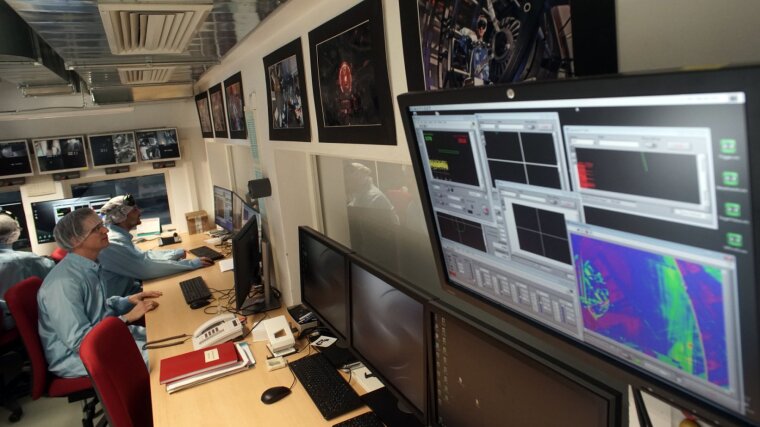
Prof. Dr. Malte Kaluza
Image: Jan-Peter Kasper (University of Jena)Prof. Dr. Malte C. KALUZA
Email: malte.kaluza@uni-jena.de
Phone: +49 3641-9-47280
Prof. Kaluza is director of the Institute of Optics and Quantum Electronics. He is a member of the extended board of directors of the Helmholtz Institute Jena, member of the Senate of the FSU Jena and the coordinator of the Erasmus Program of the Faculty of Physics and Astronomy. Dr. Kaluza is the head of the High-Intensity Laser Physics Group at the Center for Innovation Competence »ultra optics«.
The primary focus of the research group "high-intensity laser physics" lies on the development and optimization of a new class of laser systems generating pulses with peak powers in the range of 100 Terawatt to 1 Petawatt and the application of these pulses for the acceleration of charged particles such as electrons and ions to energies in the range of 10's or 100's of Megaelectronvolts.
The laser systems which are developed and utilized within this research group are fully diode-pumped solid state laser systems which offer a worldwide unique combination of high laser pulse energy (in the range of 10s of Joules), short laser pulse duration (shorter than 150 fs) and high pulse repetition rate (a few shots per minute). The POLARIS laser system which has been developed within the group currently holds the world record for the peak power of the laser pulses from such a fully diode-pumped system. Using high-power pulses from such a laser system opens up the possibility to conduct a large variety of experiments towards laser-driven particle acceleration. Both the generation of electron and ion pulses exhibiting a quasi-monoenergetic spectral distributions are among the research highlights of this group. This group was the first to be able to observe the electron acceleration process with optical methods and to visualize the so-called "plasma bubble" during the interaction, which is a prerequisite for the generation of quasi-monoenergetic electron pulses. Applications using such electron pulses for the generation of secondary radiation with unique properties are also developed in the group.
Research Areas
Prof. Kaluza's research focuses on the generation and application of pulses from the THz to the x-ray regime with extreme parameters, reaching peak powers up to Terawatt or Petawatt for the study of various phenomena in non-linear relativistic optics. These studies also include:
- Development of laser systems with peak powers from TW to PW
- Laser-based particle acceleration
- Secondary electromagnetic pulses with ultra-short duration
- High-resolution probing of transient states of matter with optical pulses and particle beams
- Development, characterization, and application of novel materials for laser operation
Teaching Fields
Prof. Kaluza’s teaching is devoted to young scientist education from their first year onward to the doctorate level using state-of-the-art research. He gives courses in:
- 1st year experimental physics
- High-intensity, relativistic optics
- Plasma physics
Research Methods
In Prof. Kaluza‘s group‘s laboratories, a wide range of methods is developed and used to generate and apply high-intensity laser pulses. These methods include:
- Operation of the POLARIS laser system
- Cryogenic cooling for laser amplifiers
- Operation of burst-mode lasers both with high peak and high average power
- High-resolution spectroscopy and characterization of laser materials
- Few-cycle optical probing techniques
- High-resolution characterization of ultra-short highenergy particle and photon pulses
Recent Research Results
The Relativistic Laser Physics Group has recently achieved considerable progress in the field of laser-driven particle acceleration. Both the generation of electron [1] and ion pulses [2] from relativistic laser-plasma interactions and the possibility to actively tailor the energy distribution of the particles offer a number of important applications for the future. Here, the application of these particle pulses, both for the realization of ultra-short x-ray pulses and for the future development of a laser-based particle accelerator for radiation therapy in medicine, are the subject of our ongoing research.
In addition, the development and application of optical probing techniques by the Relativistic Laser Physics Group has led to the first observation of transient structures in lasergenerated plasmas on µm- and fs-scales. Both the observation of the plasma wave, the transient acceleration structure in the plasma responsible for the generation of monoenergetic electron pulses, and the determination of the electron pulse duration with these techniques, have led to an insight into the acceleration mechanisms with unprecedented temporal and spatial resolution [3].
Furthermore, new approaches for the generation and amplification of high-power laser pulses have been studied by the Relativistic Laser Physics Group. These include the development and characterization [4] of new laser materials, especially Yb3+-doped CaF2 , which is well suited for diode-pumping as used in the operation of the POLARIS laser which is currently the most powerful, diode-pumped system worldwide. To enhance the performance of such laser systems, novel cryogenic cooling techniques are being developed with the aim of increasing the repetition rate of the laser pulses.
[1] Kuschel et al., Phys. Rev Lett. 121, 154801 (2018).
[2] Polz et al., Sci. Rep. 9, 16534 (2019).
[3] Downer et al., Rev Mod Phys. 90, 035002 (2018).
[4] Tamer et al., Laser & Photonics Reviews 12, 1700211 (2018).
